Effects of Nano-Aluminium on The Combustion of A PolyNIMMO-Based Propellant
2014-01-28CliveWoodleyPeterHenning
Clive Woodley,Peter Henning
(QinetiQ,MOD Fort Halstead,Sevenoaks,Kent TN14 7BP,United Kingdom)
Introduction
Substantial increases in the muzzle energy of solid propellant guns are becoming harder to achieve using conventional propellants and charges.Consequently there is increasing interest in the development of novel propellants and advanced charges such as compacted charges,foamed propellants and layered propellants.
Workers at ISL[1]have reported that a propellant containing nano-aluminium produced burn rates about a factor of two faster than conventional double base propellants.Additionally,the burn rate for the propellant showed a substantial increase at low pressure which might aid the ignition process.
Furthermore,the use of nano-metal particles is expected to aid ignition by increased energy transfer from the igniter gas to the bulk solid propellant due to the greater thermal conductivity of the metal.This same property is also expected to increase the burn rate of the propellant by increased energy transfer from the flame zone to the solid propellant.Additionally,the use of other nano-materials,such as carbon nano-tubes,might allow other ignition methods to be used that are more efficient and effective than conventional ignition methods.For example,workers in Canada have reported that 3%carbon nano-tube material in black powder was successfully ignited using a simple camera flash[2].This property would allow the use of very insensitive propellant compositions that are impossible or very difficult to ignite by other means,thereby improving the safety of munitions in storage and on the battlefield.
Workers in China have investigated the effect of nano-materials on wear and erosion and as burn rate catalysts[3-6].
The aim of the work described in this paper was to quantify the change in burn rate and ignitability of nano-aluminium propellants,and to assess these propellants for potential barrel wear.Other nano-materials may be considered in further work with the objective of identifying the most suitable nano-material in terms of high burn rate increase and no increase in wear rates.
Success criterias stated for the research project were the following:
Increased burn rate by at least 50%compared with the baseline propellant
Ignition delays no longer than those for the baseline propellant
Wear rates no more than those for the baseline propellant.
If substantial increases in burn rate can be achieved,without significant increases in ignition delay and barrel wear,then clear plans can be made to produce layered propellant grains with a view to demonstration of the concept at medium calibre.
1 Propellant-formulation Testing and Manufacture
1.1 Propellant compositions
LOVA5was chosen to be the baseline for this project as it has been manufactured in previous work using a twin screw extruder(TSE).The composition of LOVA5and the aluminium-loaded variants are shown in Table 1.
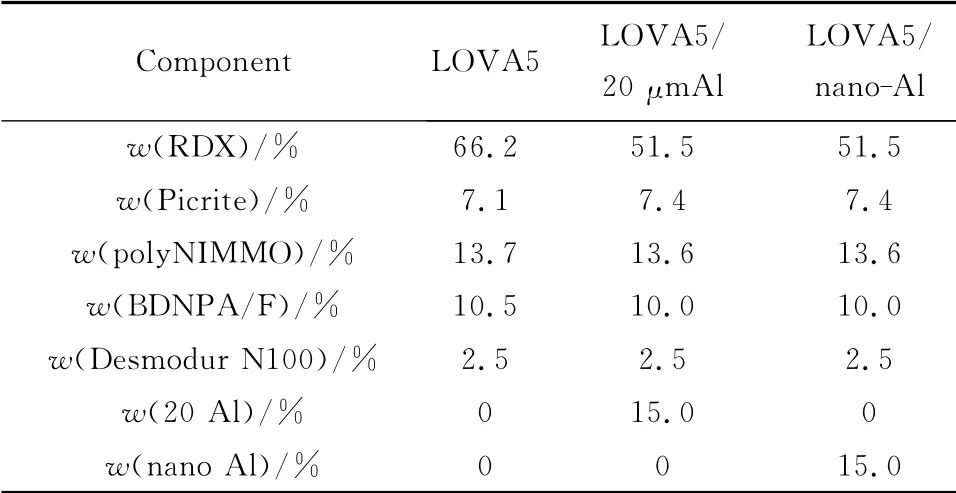
Table 1 Compositions and thermochemical parameters of propellant
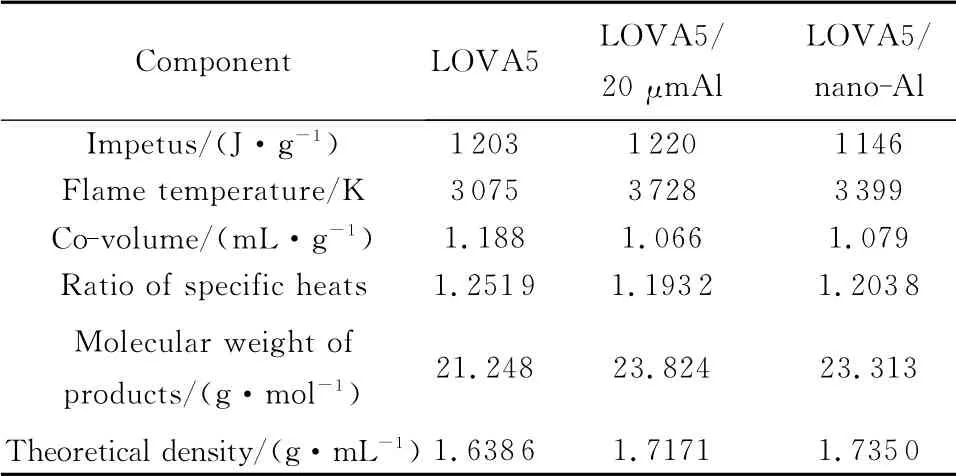
(Continued Table 1)
In order to process the aluminium-loaded propellants through the TSE,the RDX component had to be decreased.Otherwise the percentage of solid material would have been too great.The predicted thermochemical parameters and density are different for the aluminium loaded propellants because of the different purity levels of the micro-and nano-aluminium.
1.2 Aluminium characteristics and source
Passivated nano-aluminium was sourced from QinetiQ Nanomaterials Ltd(now Intrinsiq Materials Ltd).The unagglomerated particle size was estimated to be 100+/-50nm.Purity data supplied by the manufacturer are given in Table 2.

Table 2 Purity data for nano-aluminium
The micro-aluminium was obtained from Alpoco (Sutton Coldfield).The certificate of analysis indicated that the sample was 96.96%free aluminium.
1.3 Small scale testing
Standard EMTAP small scale hazard tests were performed on the two uncured aluminium-loaded compositions,produced by standard batch mixing techniques,to establish whether they could be processed safely on the TSE.The results are shown in Table 3.

Table 3 EMTAP test results
The results showed that the nano-aluminium rendered the uncured composition more sensitive to both impact and friction than the analogous composition with micro-aluminium,but that the nanoaluminium composition was less sensitive to electrostatic discharge.
The results showed that both compositions could be safely processed on the TSE at Fort Halstead,using standard safety precautions.
It should be noted that these results were obtained from the uncured compositions,as this is the state of the material during processing.The hazard properties of the final(cured)compositions cannot be inferred from these data.
1.4 Compatibility
The test procedure used followed that described in STANAG 4147and subjected the samples to 24hours at 60℃.Under these test conditions the supplied materials alone and in combination evolved the amounts of gas listed in Table 4.
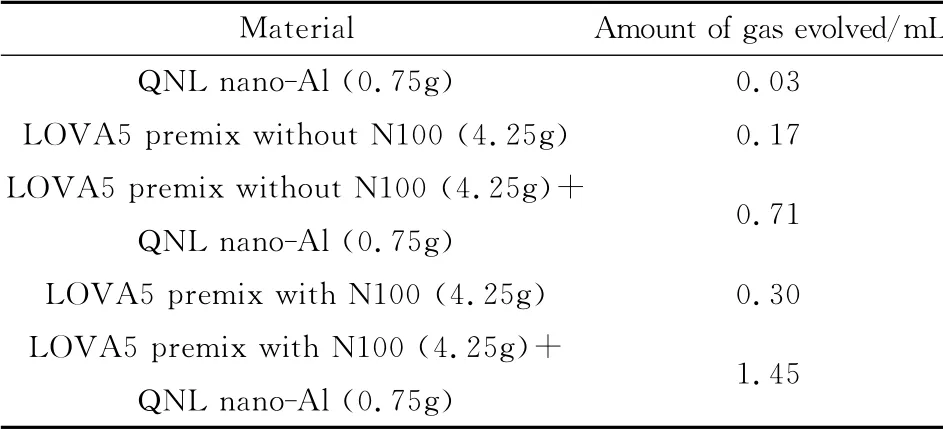
Table 4 Amounts of gas evolved in compatibility testing
There was evidence of reactivity between the nano-aluminium and the LOVA5premix which was enhanced with the introduction of the curing agent N100.It is probable that under the normal compatibility test conditions of 40 hours at 100℃using standard 1∶1 weight combinations the aluminium would be declared incompatible with LOVA5premix with added N100.However,the situation is complicated by the fact that the concentration of N100in the mix will be effectively zero after the material has cured.If gas is generated during the curing process,this will be a problem as it could cause porosity within the material.
The LOVA5/micro-aluminium composition was not compatibility tested for reasons of time-as it has a lower surface area than the nano-aluminium composition,any reaction between the aluminium and the other components of the composition would highly likely to be slower than that observed for the LOVA5/nano-aluminium material.
1.5 Manufacture method
Propellant samples for this project were produced on the Prism Energex 24mm TSE located at Fort Halstead.Prior to TSE processing of the experimental materials,test batches were produced in an IKA-25 Batch Mixer to enable collection of the safety and compatibility data discussed above.Both grades of aluminium yielded grey,doughy compositions and both were viewed as suitable for TSE processing.
LOVA5had been produced by TSE previously in programmes,which were aimed at improving the characteristics of the extruded material,notably the elimination of porosity from the final propellant.The knowledge gained from this previous work,particularly in relation to the design of the extrusion die,was employed here to minimise the amount of development work needed under this short programme.
All three propellants were processed at a rate of 0.5kg/h at a 50r/min extruder screw speed.The solid explosive ingredients(RDX and Picrite)were desensitised by premixing the powders with 3wt%of BDNPA/F plasticiser prior to extrusion.The propellants were produced in the form of solid cord,with a diameter of 2-3mm.Plate dies developed under a previous LOVA5project were used to eliminate porosity from the final material.The extrudate was collected on Tufnel sheets mounted on a custom designed haul-off unit.
Following extrusion,the propellants were cured at a temperature of 60 ℃for a period of 5days.Following cure,the propellant sticks were separated from the Tufnel sheets using a scalpel,and were cut to 55mm lengths for firing.
The production and collection of the LOVA5 propellant was straightforward,as previous programmes have given QinetiQ extensive experience of processing the material.The addition of the aluminium proved rather more problematic,for a number of reasons:
Feeding:Solid materials are fed into the extruder using two Brabender loss-in-weight feeders.In order to feed the aluminium powders into the extruder,the desensitised RDX and Picrite feeds had to be combined in the correct ratios prior to extrusion,and fed through the large solid feeder so as to enable the small solid feeder to be used for the aluminium powder.The nano-aluminium powder was especially difficult to feed,with the powder feeder having to operate at~100%speed to maintain the specified feed rate.This means that it is not possible to produce this propellant at a rate >0.5kg/h using current equipment.
Torque:The addition of the Al increased the torque required to process the propellant.An increase in temperature from 25℃to 35℃resulted in the viscosity of the mix falling to acceptable levels,but if maintained along the length of the barrel this temperature results in a semi-liquid propellant being extruded from the die.It was found necessary to adopt a decreasing temperature profile from 35℃in the mixing zone to 15℃in the die block in order to maintain acceptable torque,whilst allowing the propellant to consolidate effectively within the die.
Homogeneity:The propellant produced with the micro-aluminium was visibly less homogenous than either the LOVA5or the nanoaluminium propellants.The aluminium appeared to form relatively large agglomerates within the propellant,which could occasionally be seen breaking through the surface of the material.The mechanical properties of this material were also noticeably the worst of the three materials.
Propellant Collection:The mechanical properties of the uncured aluminised propellant were markedly different to LOVA5.In particular,the aluminised propellant displayed an increased tendency to break under the slightest applied force.This caused problems during the collection of the propellant,necessitating the haul-off unit to be adapted to reduce the distance between it and the die,as well as a re-write of the haul-off control software to enable finer control of the haul-off speed.
2 Closed Vessel Testing
For the closed vessel testing,the propellant samples cut into lengths of 55 mm and the diameters of ten sticks were measured.The mean diameters,with the standard deviation,are listed in Table 5.The difference in mean diameters of the three propellants was taken into account in the analysis of the pressures from the closed vessel firings.

Table 5 Propellant mean diameter and standard deviation
The reduced standard deviation for the nano-aluminium propellants was attributed to the following factors:
·The haul off arrangement had been optimised by the time the nano-aluminium sample was produced. This means that the propellant was less prone to“draw down”i.e.to become thin due to small variations in the rate at which the propellant emerges from the extruder.
·The mechanical properties of the uncured nano-aluminium material were vastly superior to the micro-aluminium material.This meant that it was more easily moulded by the die and generally a more consistent product.
·The die was changed slightly after producing the LOVA5,which gave a more consistent product.
Three rounds of each propellant were fired at 16℃in a nominal 80mLclosed vessel.Except for the micro-aluminium propellant,all charge masses fired were 16g,giving a loading density of 0.2g/mL.The micro-aluminium propellant was noticeably much softer than the other two propellants and there were concerns about it breaking up during the closed vessel firing and possibly damaging the vessel.Therefore reduced charge masses of 10g and 13g were used to gain confidence in its combustion behaviour before finally using 16g.
Good round-to-round consistency was achieved in the closed vessel firings.The average burn rate profiles are compared in Figure 1.The micro-aluminium propellant showed about a 10%increase in burn rate compared with the baseline LOVA5 propellant.The nano-aluminium propellant showed a substantial increase (about 40%)in burn rate.The calculated burn rate data(burn rate coefficient and burn rate pressure exponent)are shown in Table 6.The presence of the nano-aluminium caused a substantial derease of 25%in the burn rate pressure exponent.This feature makes nano-aluminium a very desirable additive to use in the production of‘low alpha’artillery propellants to realise uni-modular propelling charge systems.
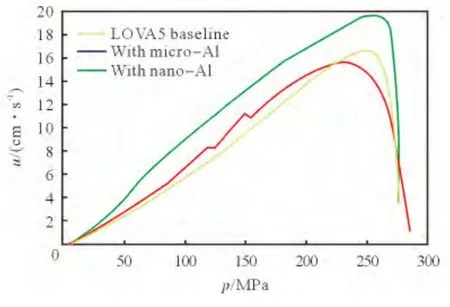
Fig.1 Comparison of burn rate profiles
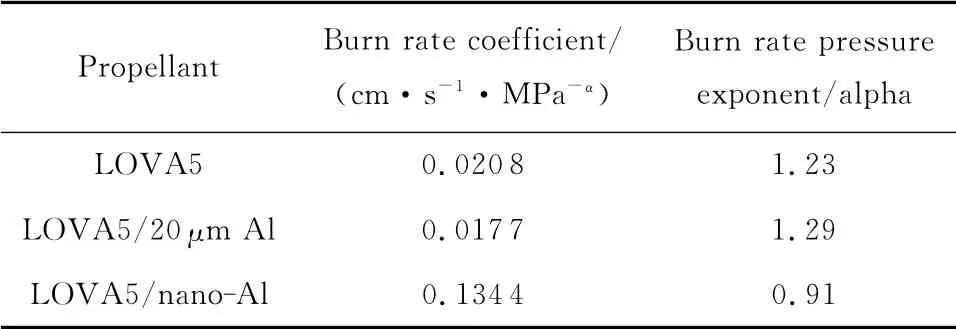
Table 6 Burn rate coefficient and burn rate pressure exponent
Figure 2compares the ratio in the burn rates for the nanoaluminium LOVA5and baseline LOVA5 propellants.During the main combustion region of 30-250MPa(i.e.neglecting the ignition and end of combustion phases),the average burn rate increase was 39%.In particular,the burn rate increase at low pressure(50-100 MPa)was about 70%,thus confirming the findings of the ISL workers.However,the burn rate increase was not as fast as the 100%increase reported.One difference might be that their result was obtained with a conventional double base propellant.Also,in the explosives field,very large differences in nano-aluminium,mainly due to differing oxide content,have been found.This is attributed to the way the particles are made and how they are passivated.
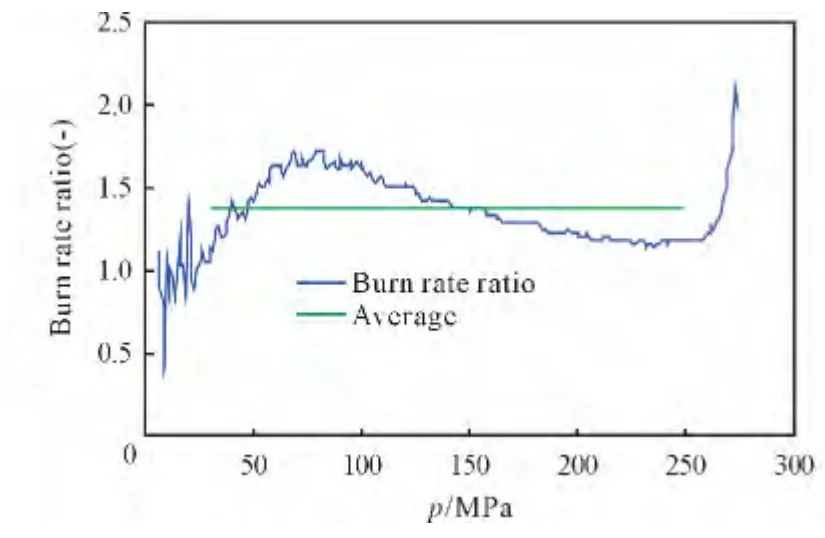
Fig.2 Burn rate ratio between nano-Al LOVA5 and baseline LOVA5 propellants
One round each of the baseline LOVA5and nano-aluminium LOVA5propellants were also fired at+52℃and-33℃to check the combustion behaviour at hot and cold temperatures.The hot temperature burn rates revealed the expected small increase in burn rate with increased temperature.However,the-33℃firing of the nano-aluminium LOVA5propellant showed an anomalous increase in burn rate after a pressure of 80 MPa(Figure 3).The nano-aluminium LOVA5 propellant appeared to burn normally up to 80 MPa,thereafter the burn rate increased rapidly to a level about 2.5times faster than that of the baseline LOVA5propellant.Such an increase might occur due to the propellant breaking up,giving rise to an increase in the burning surface area which would appear in the analysis as an increase in the burn rate.The analysis method assumes that propellant burning takes place in parallel layers.
Although only one round was fired,which is not statistically significant,further work needs to be conducted to investigate the causes of this anomalous burn rate behaviour.The glass transition temperature should also be measured.It is possible that the problem was caused by the very high volumetric loadings leading to stress concentration effects between the particles which,when the temperature was lowered,brought the rubbery binder into the glass phase transition region.On the basis of this single result,gun firings of the propellant at cold temperature would be unsafe.

Fig.3 Comparison of burn rate of nano-Al LOVA5 at+16℃and-33℃
Figure 4compares the dynamic vivacity profiles for the three propellants at+16℃.Of interest in this figure is the shape of the profiles,over the region 0.2-0.8of P/Pmax,rather than the absolute levels(the difference in propellant diameter makes it difficult to compare the levels).P/Pmax is the ratio of the pressure to the maximum pressure.In general,if the slope is increasing,the gas generation rate from the burring propellant is increasing,i.e.the combustion is progressive.On the other hand,if the slope is decreasing,then the propellant is burning in a degressive manner.For cord propellant,the combustion is degressive,but the effect of a burn rate exponent greater than one will increase the dynamic vivacity as the pressure increases,making the combustion appear neutral or even progressive.Clearly the presence of micro-aluminium in LOVA5appears to result in a more progressive burning propellant,whereas the presence of nano-aluminium in propellants results in a more degressive burning propellant.
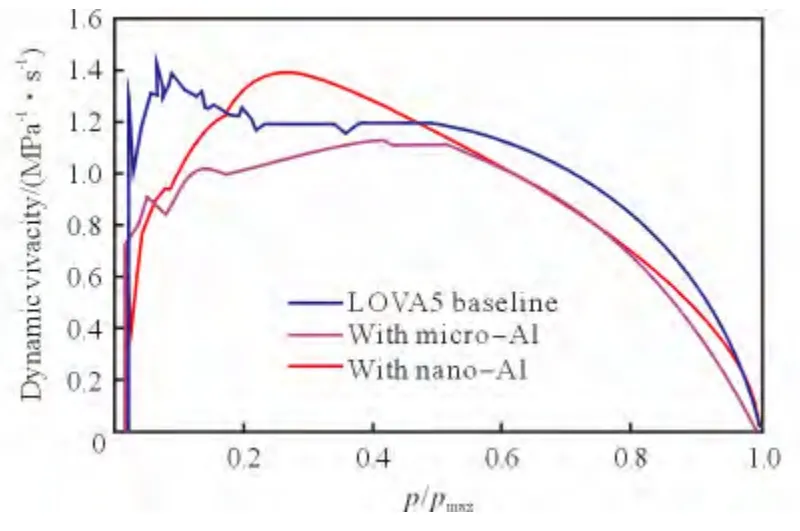
Fig.4 Comparison of dynamic vivacity profiles at+16℃
3 Wear Tests
To determine the wear rates for the three propellants,a specially modified vented vessel was used.This vessel incorporated a steel nozzle through which the combustion products vented during the firing.By measuring the mass of the nozzle before and after each firing,the mass loss per round,and hence wear rate,was determined.A separate nozzle was used for each propellant.
Figure 5compares the cumulative nozzle mass loss for each of the three propellants for five rounds,each using 20g of propellant.The mass loss rate for the micro-aluminium LOVA5propellant is a factor of 6greater than that for the baseline LOVA5propellant.Although the mass loss rate for the nano-aluminium LOVA5propellant is about 60%of that for the micro-aluminium propellant,it is 3-4times greater than that for the baseline propellant.However,it is not clear whether the increased wear rates for the aluminiumloaded propellants are due to the increased flame temperatures-the micro-aluminium propellant is 650Khotter and the nano-aluminium propellant is 300Khotter than the baseline propellant-or due to the abrasiveness of the aluminium products of combustion(or both).
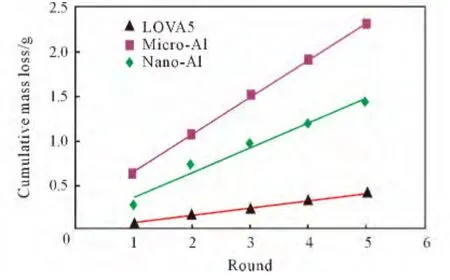
Fig.5 Cumulative nozzle mass loss for the three propellants
One noteworthy feature of the nano-aluminium propellant firings was the coating of the inside of the vented vessel with a fine layer of whitish powder.This powder was probably primarily aluminium oxide.It was also difficult to remove.
4 Ignition delay
From the closed vessel tests,the ignition delay was taken to be the time up to 5 MPa.It was possible to compare only the ignition delays for the baseline LOVA5 and nano-aluminium LOVA5 propellants because there was only one micro-aluminium LOVA5 propellant firing at the same conditions.The calculated mean ignition delay for the LOVA5 baseline was 12.82 ms,which compares with 11.56ms for the nano-aluminium LOVA5propellant.However,due to the small number of results,this difference is not significant at the 5%level.
For the vented vessel tests,five rounds of each propellant were fired.Again the time taken to reach 5 MPa was noted.The calculated mean ignition delays of the baseline propellant,the microaluminium propellant and the nano-aluminium propellant were 19.296ms,19.532ms and 19.239ms,respectively.These differences are not statistically significant.
5 Conclusions
The following achievements have been shown for nano-aluminium propellant:
·Increased burn rate by 70%at low pressure(50-100 MPa)albeit only an average 40%increase for the whole burn(Target:at least 50%)
·Ignition delays shorter than those for the baseline propellant(Target:no longer)
·Wear rates substantially lower than for the micro-aluminium LOVA5but substantially greater than those for the baseline propellant.(Target:no worse).
The reduction in burn rate pressure exponent will benefit the design of low alpha propellants and will help to realise uni-modular propelling charge systems.
Optimisation of the nano-loaded propellant will allow the production of layered propellants giving a 10%-20%increase in muzzle velocity,which will be of great benefit to all small arms,medium calibre and large calibre gun systems including naval guns,land based artillery guns and direct fire guns.
Acknowledgement
This work was funded by the Defence Science and Technology Laboratory(Dstl)part of the UK MoD,under the Hazard Modelling and Simulation task of the UK Energetics(UK-E)programme now consumed by the Weapons Science and Technology Centre(WSTC).
[1] Baschung,Grune,Licht &Samriant,Combustion phenomena of a solid propellant based on aluminium powder[C]∥Proceedings of the 5th International Symposium on Special Topics in Chemical Propulsion (5-ISICP ). Stresa (Lake Maggiore),2000.
[2] Desilets,Brousseau &Cote,Ignition of energetic materials containing carbon nanotubes[C]∥Proceedings of the 34th ICT(Institute of Chemical Technology)Conference on Energetic Materials.Karlsruhe:ICT,2003.
[3] Song Qiuzhi,Chen Yongcai,et al.Research on effect of adding nanomaterial to propellant on gun barrel[J].Journal of China Ordnance,2010,6(1):48-53.
[4] Fan Li,Duan Tao.Application of Nanocatalysts in Energetic Matarials[J].Guangzhou Chemical Industry,2010(12):25-26.
[5] KANG Yong.Application progress of nanometer-sized metal catalyst in propellants[J].Ordnance Material Science and Engineering,2012(1):97-101.
[6] Zhang Yingjie,Li Hangduo.Research progress of nano-structured burning rate catalyst[J].Ordnance Material Science and Engineering,2012(4):112-115.
